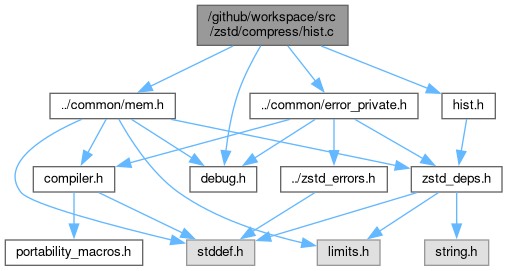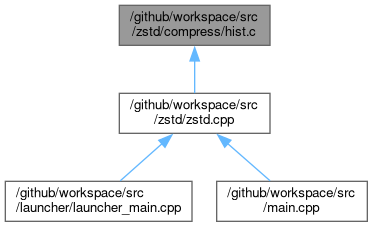#include "../common/mem.h"#include "../common/debug.h"#include "../common/error_private.h"#include "hist.h"

Go to the source code of this file.
Enumerations | |
| enum | HIST_checkInput_e { trustInput , checkMaxSymbolValue } |
Functions | |
| unsigned | HIST_isError (size_t code) |
| unsigned | HIST_count_simple (unsigned *count, unsigned *maxSymbolValuePtr, const void *src, size_t srcSize) |
| size_t | HIST_countFast_wksp (unsigned *count, unsigned *maxSymbolValuePtr, const void *source, size_t sourceSize, void *workSpace, size_t workSpaceSize) |
| size_t | HIST_count_wksp (unsigned *count, unsigned *maxSymbolValuePtr, const void *source, size_t sourceSize, void *workSpace, size_t workSpaceSize) |
| size_t | HIST_countFast (unsigned *count, unsigned *maxSymbolValuePtr, const void *source, size_t sourceSize) |
| size_t | HIST_count (unsigned *count, unsigned *maxSymbolValuePtr, const void *src, size_t srcSize) |
Enumeration Type Documentation
◆ HIST_checkInput_e
| enum HIST_checkInput_e |
Function Documentation
◆ HIST_count()
| size_t HIST_count | ( | unsigned * | count, |
| unsigned * | maxSymbolValuePtr, | ||
| const void * | src, | ||
| size_t | srcSize | ||
| ) |
HIST_count(): Provides the precise count of each byte within a table 'count'. 'count' is a table of unsigned int, of minimum size (*maxSymbolValuePtr+1). Updates *maxSymbolValuePtr with actual largest symbol value detected.
- Returns
- : count of the most frequent symbol (which isn't identified). or an error code, which can be tested using HIST_isError(). note : if return == srcSize, there is only one symbol.
Definition at line 175 of file hist.c.

◆ HIST_count_simple()
| unsigned HIST_count_simple | ( | unsigned * | count, |
| unsigned * | maxSymbolValuePtr, | ||
| const void * | src, | ||
| size_t | srcSize | ||
| ) |
HIST_count_simple() : Same as HIST_countFast(), this function is unsafe, and will segfault if any value within src is > *maxSymbolValuePtr. It is also a bit slower for large inputs. However, it does not need any additional memory (not even on stack).
- Returns
- : count of the most frequent symbol. Note this function doesn't produce any error (i.e. it must succeed).
Definition at line 29 of file hist.c.

◆ HIST_count_wksp()
| size_t HIST_count_wksp | ( | unsigned * | count, |
| unsigned * | maxSymbolValuePtr, | ||
| const void * | src, | ||
| size_t | srcSize, | ||
| void * | workSpace, | ||
| size_t | workSpaceSize | ||
| ) |
HIST_count_wksp() : Same as HIST_count(), but using an externally provided scratch buffer. Benefit is this function will use very little stack space. workSpace is a writable buffer which must be 4-bytes aligned, workSpaceSize must be >= HIST_WKSP_SIZE
Definition at line 154 of file hist.c.


◆ HIST_countFast()
| size_t HIST_countFast | ( | unsigned * | count, |
| unsigned * | maxSymbolValuePtr, | ||
| const void * | src, | ||
| size_t | srcSize | ||
| ) |
HIST_countFast() : same as HIST_count(), but blindly trusts that all byte values within src are <= *maxSymbolValuePtr. This function is unsafe, and will segfault if any value within src is > *maxSymbolValuePtr
Definition at line 168 of file hist.c.

◆ HIST_countFast_wksp()
| size_t HIST_countFast_wksp | ( | unsigned * | count, |
| unsigned * | maxSymbolValuePtr, | ||
| const void * | src, | ||
| size_t | srcSize, | ||
| void * | workSpace, | ||
| size_t | workSpaceSize | ||
| ) |
HIST_countFast_wksp() : Same as HIST_countFast(), but using an externally provided scratch buffer. workSpace is a writable buffer which must be 4-bytes aligned, workSpaceSize must be >= HIST_WKSP_SIZE
Definition at line 140 of file hist.c.


